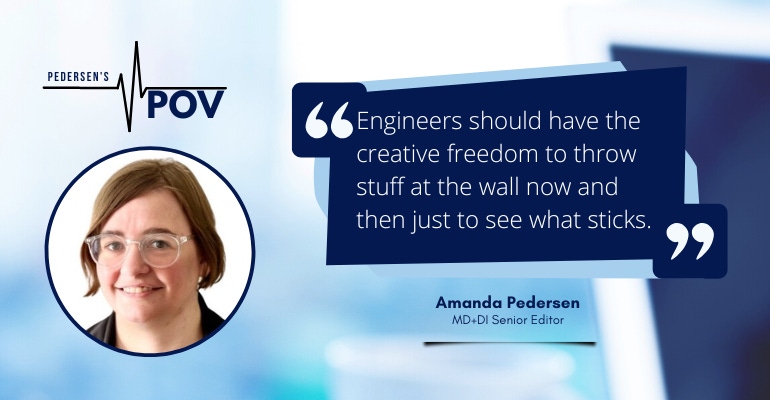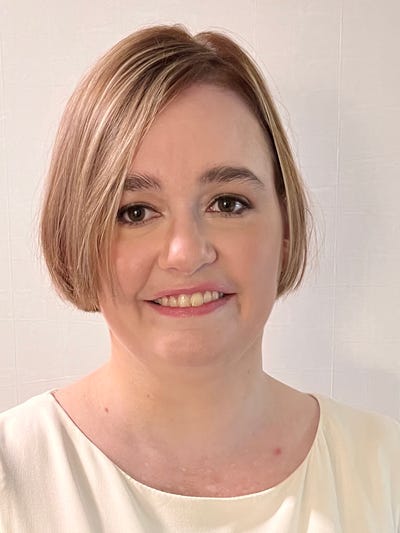Your Medtech Project Flopped, Now What?
This week in Pedersen's POV, our senior editor addresses the stigma of failure in medtech R&D.
March 27, 2023

The medtech industry is full of success stories, but the savvy R&D professional knows the best learning opportunities come from the projects that fail.
I still remember sitting in a panel session at MD&M Minneapolis back in 2017 when Dale Larson shared a failure story with the audience. It was the first time in a decade of medtech coverage that I’d ever heard someone in the industry voluntarily talk about a failed project.
Larson, at that time, was with Draper Laboratory. Today, he is the founder and CEO at EOT Biosystems, a firm that is working to commercialize a technology from Harvard Medical School and Northeastern University.
The story he shared was about an internal R&D project Draper had pursued involving bioresorbable electronics, a technology that initially seemed like it would have a lot of potential in healthcare.
"We were working with some surgeons at the Brigham and Women's Hospital, and we hit upon this thing called a surgical leave-behind sensor, something that the surgeon wanted to query post-operatively," Larson said. "And everybody got excited. The surgeons were foaming at the mouth, the engineers were like 'yes, it's going to go'. But then we asked, 'What are you going to measure?'"
After drilling it down a bit, the team discovered there wasn't really anything of great value that could be measured with what was, at the time, a very primitive set of electronics.
"I killed the project because we couldn't come up with a killer app," Larson said. "It still hurts, and it's been five years since we've killed it."
And keep in mind, this panel discussion took place nearly six years ago, so we’re talking about electronics from over a decade ago.
But, as painful as that kill was, Larson and his team learned a valuable lesson. Making cool stuff is great, but there must be a clear application for the technology.
Inspired by Larson's valor, fellow panelist Alex Thaler shared a story from his brief stint at a company called Perspire Diagnostics that flopped. Thaler, who just recently transitioned to independent consulting after years of working in strategy and operations roles, talked about how Perspire wanted to develop lab tests using patients’ sweat.
"A few months in, we found that the correlation exists at an aggregate level, but not at a specific patient level,” Thaler said. "It would be an amazing story to tell if it had worked out.”
But these experiences are in no way limited to startups and smaller R&D organizations. During a separate session at the same conference, Steve Geist, director of R&D within the transcatheter mitral and tricuspid therapies division at Edwards Lifesciences, emphasized the important role failure plays in innovation.
"The learnings that come from failure are fundamental to future successes," Geist said.
He used the example of a time when Edwards decided to kill a project the company was working on in-house. The learnings from that project were later applied to a platform Edwards acquired, Geist said.
Sometimes a technology is simply ahead of its time. Going back to the Draper example, that leave-behind sensor might not have had a clear application 11 years ago, but it sounds an awful lot like the technology Zimmer Biomet is now using in its “smart” knee replacement devices. The Persona IQ knee implants have a built-in sensor developed by Canary Medical that post-operatively measures a patient’s range of motion, step count, walking speed, and other gait metrics.
I was reminded of these medtech failure stories during my recent Let’s Talk Medtech podcast conversation with Penumbra CEO Adam Elsesser.
“Our team has this attitude that I think allows them to always be open to learning what they don't know, and not being afraid to fail, and just always keeping their eye on sort of what matters,” Elsesser said. “…We value that, and we've rewarded that, and so it propagates.”
At first, I thought he was referring to the business cliché of failing fast.
“It's a little different than fail fast,” he said. “It's just the fundamental idea that, ‘So what if you fail?’ Like, a lot of companies, failing comes with sort of a political taint, you know? Like, ‘oh, you were on that project?’ You know what I mean? And here we really don't have that.”
It was incredibly refreshing to hear medtech CEO openly talk about failure in this way. Elsesser made an excellent point when he said there’s a sense at many other companies that you want to be on the projects that are going to succeed, which tend to be easier projects.
But imagine if that mentality plagued every medtech company. The market would be even more saturated with “me too” devices and iterative developments than it already is, and there would be so many missed opportunities for truly meaningful innovation.
Penumbra has explored plenty of ideas that didn’t work out, but Elsesser knows there’s nothing wrong with that. He doesn’t expect his team to bat 100%. In turn, he said, Penumbra’s R&D team is “untouchable.”
“People try to recruit them a lot and I am very proud to say we almost never lose anyone because they're pretty happy to be at a place like this that values what they do so well,” he said.
That type of company culture is so important in today’s unstable workforce environment. Engineers should have the creative freedom to throw stuff at the wall now and then just to see what sticks. If they’re not getting that at their present company, they might be inclined to go somewhere more like Penumbra.
The vascular device company also has one of the more prolific R&D teams in the industry, with somewhere in the ballpark of 50 new product launches since Penumbra went public in 2015. You don’t get that kind of output from R&D teams that are afraid to fail.
I’m not suggesting companies throw caution to the wind and invest in projects haphazardly. But when your project does flop, it’s important to file it away as a learning experience and move on. You never know when an idea from a past “failure” might help to inform the design of a future project.
About the Author(s)
You May Also Like



.png?width=300&auto=webp&quality=80&disable=upscale)
